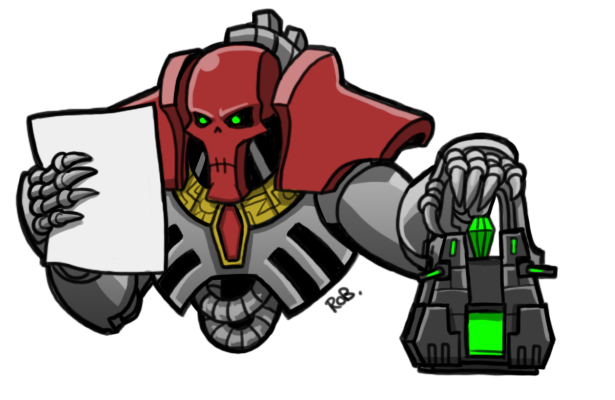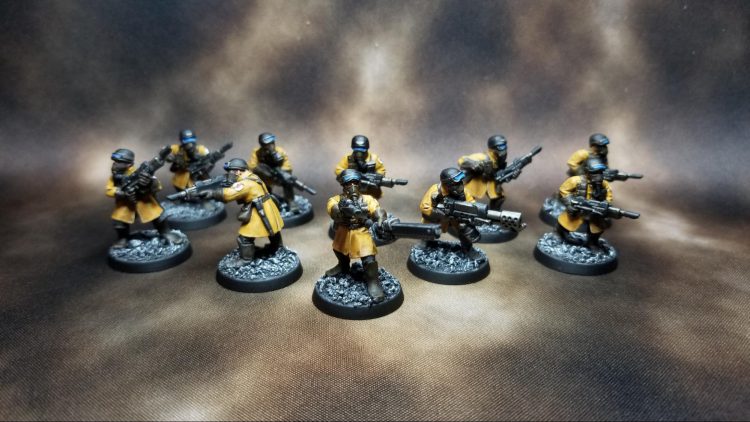If you’re new to Warhammer 40,000, then the array of different armies and supplemental rules available to them can seem overwhelming. You’ve got your codex, but what about your codex supplement? Does your army have any Forge World units? What’s a Vigilus, anyway? In this article, which we aim to maintain and keep as current as possible, we break down the where and why of Warhammer 40k.
For each faction, we’ll briefly describe the rules available to it narratively, and where and why you might use them, and then link to the various sources of those rules. It’s worth bearing in mind that although our links go to the paper versions of the books (except White Dwarf where the version you can still buy is usually the ePub), most of this stuff is available in either ebook or enhanced iBook versions and they’re also perfectly valid and you should go buy them if you prefer them.

The Core Rules
The hardback version of the core rules is found in the Warhammer 40,000 rulebook. This is the full core rulebook – there are also starter sets in Recruit, Elite, and Command edition (given in order of price and contents) which contain slimmed down versions of the rules for beginning play and are a great way to get started if you’re new. If you get the biggest version, the Command Set, there’s even a version of the full core rulebook included sans fluff text and such.
Three Ways to Play
Games Workshop has divided 40k play into three general categories: Open Play, Matched Play/Competitive Play, and Narrative Play. Depending on what kind of 40k experience you’re going for, there are different sets of rules for each.
Open Play
The mode where you just mash models together on a kitchen table or you floor. You don’t need any other core rules to play this way (though we’d recommend picking up your army’s Codex rather than using the datasheets that come in the model boxes), but if you are playing Open Play you may want more than a single mission to play with. In that case, we’d recommend picking up a copy of the Open War deck, a series of cards used to randomly generate Open Play Missions.
If you want something a bit more competitive but without the complication of picking secondary objectives, then consider picking up the Tempest of War Deck, which has a similar card-based mission generation system but a much tighter, more tactical rule set that rewards thinking on your feet mid-game.
Crusade and Narrative Play
If you’re planning to play Crusade, then the Core Rules have everything you need. Your army’s Codex will also give you additional Crusade rules you can use to enrich the experience, but these aren’t strictly necessary to start your army’s path to glory. Over the course of 9th edition Games Workshop have released a number of Crusade Mission packs such as Beyond the Veil and Plague Purge; these introduce new missions to the Crusade game format and additional rules, but they are by no means necessary to play. The best of these from a pure “quality of missions” standpoint is probably Amidst the Ashes, but again you don’t need it to play Crusade and have a great time. The other notable books here are Containment, which has the Planetstrike rules, and Catastrophe, which has rules for 3-player games.
The Campaign books also have Narrative and Crusade rules that they add to the game, though again these aren’t strictly necessary to play and they can be a bit of a chore to dig up now. Both War Zone Octarius books provide some great guides for building tree campaigns, and of those, Critical Mass also provides updated rules for Fortifications.
Matched and Competitive Play
Even if you’re not planning to play at tournaments, you’ll likely want to play with points values, army lists, and the balance patches and updates that make the game a much more rewarding and challenging experience for players of a similar skill level. That’s where matched play comes in. For matched play, you’ll want the latest copy of the GT Missions Pack, which contains the current missions and game rules being used for Matched Play. Right now, that’s the War Zone: Nachmund Missions Pack. The Nachmund missions pack also comes with a Munitorum Field Manual containing most of the current, updated point values for the game’s units, which have been updated to rebalance some of the Codexes. Speaking of which, you’ll also want your army’s Codex, but we’ll talk more about that later, in the faction-specific sections.
Additionally, if you are interested in the specialist units available from Forge World, which do not form part of the main GW line but are now usually considered legal for matched play and tournaments, you will need the the Imperial Armour Compendium. This has the benefit of being comprehensive, covering the entire current Forge World range, with the downside of being comprehensive, covering the entire Forge World range, which means that if you just have a single cool toy you want the rules for you still need to pay for and then carry around a £40 hardback book. If you’re just dipping your toe into 40k for the first time you do not need this book, though it’s helpful to know it exists.
FAQs and Balance Updates
Over the course of 9th edition Games Workshop have made a number of updates to the game to improve balance between the factions, correct errors, clear up ambiguous rules text, and ensure more even matchups between players. The latest set of FAQs that do this can be found here. In particular, it’s worth it to grab the FAQ for the Core Rules, which cleans up a lot of issues, and the Designer’s Commentary, which clarifies and streamlines the Fight phase and the whole who fights first/second/last timing. We’d also recommend grabbing the FAQ for the Imperial Armour Compendium if you’re using Forge World units, and the FAQ for your army’s Codex.
Older Rules – What’s Still Legal?
As Games Workshop has introduced new rules in 9th edition, they’ve made older rules invalid or obsolete. Fortunately, they’ve published a guide to what’s currently considered “valid” in Matched/Competitive Play. You can find that guide here.
What’s an Index?
If you’re talking to people who’ve been playing a while, they might reference the “Index” books which came out at the same time as 8th edition released. These 5 books had all the datasheets and points at the launch of the game, but they’ve been completely superseded by this point – they are no longer for sale and none of the datasheets are current, either having been released in a codex, in a White Dwarf article, or transferred to “Legends.”
Wait, Legends?
Speaking of Legends, you can find them here on the Warhammer Community website. Legends incorporates rules for models which no longer exist and are therefore not supported. They have game-legal rules, but they’re no longer part of the “main” range and do not receive rebalancing. It’s also where rules go for limited releases like Da Red Gobbo from Christmas 2019. Whether you or your friends want to play with the Legends rules is completely up to you, but be aware that if you’re going to an organised play event like a tournament they probably won’t allow them.
And what about Vigilus?
If you read any of the Start Competing articles written for 8th edition, you’ll see a fair number of references to the Vigilus Defiant and Vigilant Ablaze books. In terms of rules content, Vigilus Defiant nearly 100% consisted of specialist detachments. For the most part, these are no longer legal in 9th edition, save some datasheets and subfaction updates for the Chaos Space Marines. Note that those rules have been reprinted in the campaign book War Zone: Charadon – Book 2: The Book of Fire.
And Psychic Awakening?
Like Vigilus, Psychic Awakening was a campaign series, which filled the final months of 8th edition. There were 9 Psychic Awakening books in total, starting with Phoenix Rising and ending with Pariah. Each book contained some narrative as well as new rules for a number of factions, which ranged from ‘complete garbage’ to ‘utterly essential.’ As 9th edition Codexes have come out, these have been replaced and most are no longer valid. As of this writing only four are still legal for matched play use:
- Faith and Fury, specifically the rules for the Traitor Legions that have been reprinted in War Zone: Charadon – Book 2: The Book of Fire
- Engine War, specifically the rules for Chaos Daemons
- War of the Spider, specifically the rules for Creations of Bile which were also reprinted in the Book of Fire
- The Greater Good, specifically the rules for the Astra Miiltarum
These are largely on their way out. We’ve included reference to them for each faction below where it’s relevant, and removed them where it’s not.
The FAQs and Errata
Finally, it’s worth being aware of the FAQ pages on Warhammer Community, which you can find here. Back in the bad old days FAQs were few and far between, but modern Games Workshop is at least trying to keep on top of the game and release regular updates – books generally receive an FAQ and errata about 2-4 weeks after release, and then there’s a cycle of quarterly balance updates with bi-annual points updates. Starting with the next points update at midyear, Games Workshop will be releasing points updates digitally and for free.
Isn’t there an app for this?
Short answer: yes.
Long answer: yes, but it’s quite bad. In its present form it’s not quite as bad as it was in our initial review, but at time of writing it still lacks the army builder advertised, its presentation is still poor, and it now has the odd problem of the content you get on the paid subscription reducing as time goes on – you can still access any 8th edition content that hasn’t been replaced, but for new books such as the 9th edition codexes you need to scan an app code to get access to the content at all, by buying a physical book. This means that your £3.99/month subscription got you all the rules at the end of 8th, which was convenient even if not presented that well, but as time goes on you can access fewer things without spending money purchasing the books. As things stand, at some future point your subscription will get you literally nothing. It’s a baffling situation all round. On the plus side, if you have content unlocked it’s quite helpful as a reference, and it does generally include FAQ and errata changes
Imperium

Adepta Sororitas/Sisters of Battle
The Sisters of Battle have their Codex and two Army Supplements to pick up if you want the full range of competitive options for them.
- The Codex contains the vast majority of the rules for playing Sisters, plus Cruasde rules for the faction.
- War Zone: Charadon Act 2 – The Book of Fire contains a Codex supplement with rules for playing the Our Martyred Lady subfaction of the Adepta Sororitas.
- War Zone: Vigilus – Vigilus Alone contains a Codex Supplement with rules for playing the Bloody Rose subfaction of of the Adepta Sororitas.
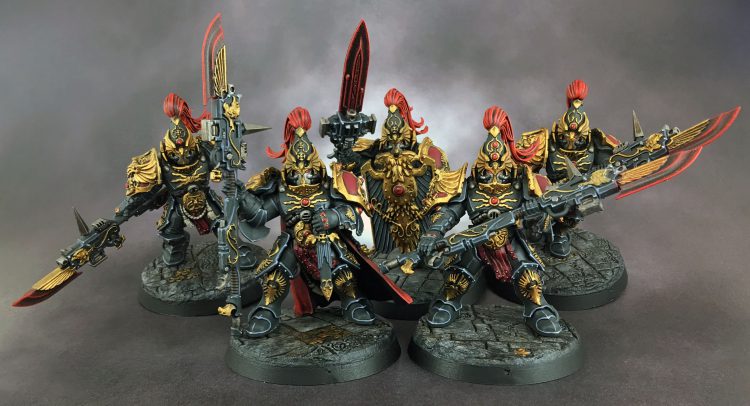
Adeptus Custodes
The Adeptus Custodes have a small, self-contained plastic range, being a new faction release for 8th edition designed to incorporate as few kits as possible. They also have an extensive range of Forge World kits, many originally designed for the Horus Heresy/Warhammer 30k setting, which have been given rules for 40k. Their 9th edition codex was extremely good on release, and in the April balance dataslate received some heavy nerfs.
- The Codex contains most of the rules you’ll need for playing Custodes, plus Crusade rules.
- Imperial Armour Compendium has the datasheets for the Forge World units that often supplement those forces, though note that there are a lot of updates and edits to this in the current FAQ for the book.
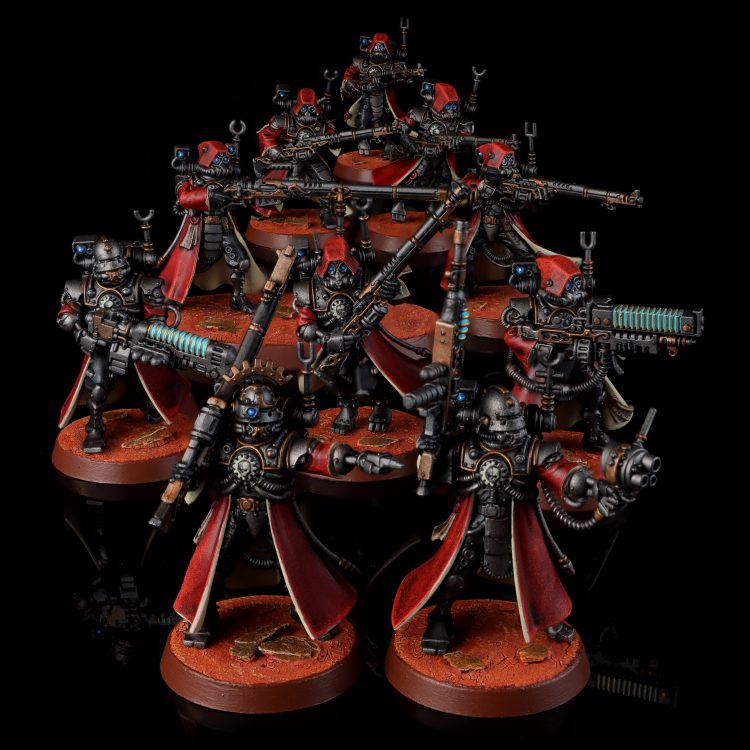
Credit: Pendulin
Adeptus Mechanicus
The Adeptus Mechanicus have rules in a bunch of different places, owing to their relationship to knights and being in several campaign books.
- The Codex has the rules for playing the faction, and their Crusade rules.
- War Zone: Charadon – Act 1: The Book of Rust has a Codex Supplement with rules for playing the Metalica Forge World and an Army of Renown for the Mechanicus Defense Cohort.
- War Zone: Charadon – Act 2: The Book of Fire has an Army of Renown for the Skitarii Veteran Cohort, which is considered one of the more powerful builds for the faction.
Astra Militarum/Imperial Guard
The Imperial Guard haven’t had much in the way of releases in 9th ed. The Guard did get a pile of new rules in Psychic Awakening: The Greater Good which any player will want to pick up if they can. Additionally, the Astra Militarum have probably the greatest number of Forge World units, matched only by the Space Marines.
- The Codex for the Astra Militarum is still the 8th edition one, and has rules for the faction, but does not have Crusade rules.
- Imperial Armour Compendium has the rules for the faction’s Forge World units.
- Psychic Awakening: The Greater Good adds rules for Tank Aces and Scions regiments.
- Severina Raine: Datasheet
- War Zone Octarius Book 1: Rising Tide has both a Codex Supplement for playing a Cadian army with your Guard, as well as some limited Crusade rules for the faction.

Credit: Pendulin
Grey Knights
The Grey Knightts are one of the least complicated armies in 9th edition. Pick up The Codex for their matched play and Crusade rules and you’re good to go!
Imperial Knights
The Imperial Knights received a new Codex in May 2022, which rendered their rules in the War Zone Charadon book obsolete. As such, if you want to play Imperial Knights you just need a copy of The Codex. You’ll also likely want a copy of Imperial Armour Compendium however, as there are a bunch of additional knight options in that book. Be sure to get the latest FAQ as well.
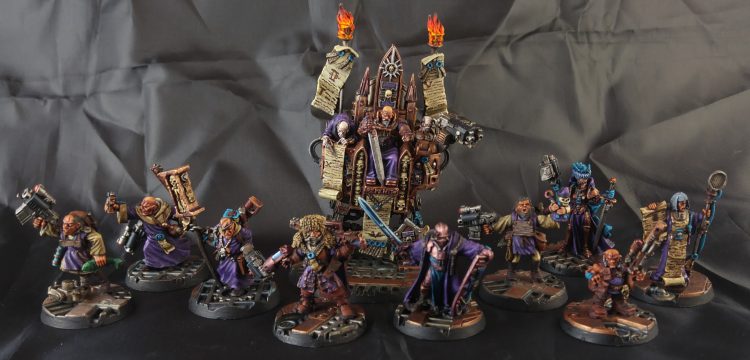
Inquisition
The Inquisition don’t have a Codex, but you can find rules for running them in your armies in War Zone Octarius Book 1: Rising Tide, which contains the Appendix: Inquisition with updated rules for running them in 9th edition. You may also want to pick up Imperial Armour Compendium, which has rules for a few additional Inquisitors.

Officio Assassinorum
The Imperial Assassins very likely single-handedly forced GW to bring back digital White Dwarf, since their rules were released in the March 2019 White Dwarf and therefore needed to be available in more than print form. They’ve seen been reprinted in Psychic Awakening: War of the Spider, with slight tweaks, and these are still the current rules for them.
Psychic Awakening: War of the Spider (FAQ version 1.0 last updated 27/7/20)
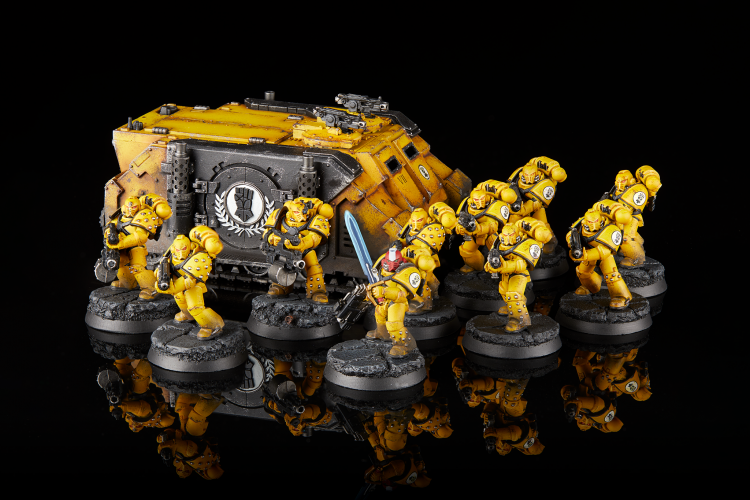
Space Marines
Along with Necrons, Space Marines got the first codex of 9th edition. This book neatly consolidates all the Marine factions into one book, with only the Grey Knights (who are proper weird) being kept separate and the rest of the ‘divergent’ Marine chapters and the Deathwatch rolled in. The supplements remain live, and there are new supplements on the way for Blood Angels, Dark Angels, Deathwatch, Black Templars, and Space Wolves, so you’ll need the main codex and then a supplement for your chosen Chapter. In addition, there are three chapters and some armies of renown which show up in other books, and we’ll detail those here as well.
- The Space marines Codex has the matched play and Crusade rules for every Marines army, and you’ll need it regardless of which chapter you want to play.
- Vigilus Alone has rules for the Vanguard Spearhead Army of Renown as well as the Gravis Captain, Primaris Ancient, and Crusade rules for having special battle standards (these are actually pretty cool).
- Rift War has rules for the Castellans of the Rift chapter
- White Dwarf had rules for the Emperor’s Spears, Tome Keepers, and Exorcists chapters. They’re kind of neat if you really want them, but nothing particularly amazing or competitively worthwhile.
Codex Supplements
- Black Templars
- Blood Angels
- Dark Angels
- Deathwatch – note that you’ll also want to pick up War Zone Octarius Book 1: Rising Tide for the Death Watch Army of Renown: Kill Team Strike force rules. These are widely considered the most competitive way to play the faction.
- Imperial Fists (8th)
- Iron Hands (8th)
- Raven Guard (8th)
- Salamanders (8th)
- Space Wolves
- Ultramarines (8th)
- White Scars (8th)
Chaos

Chaos Daemons
Chaos Daemons have a codex, a somewhat weird selection of Forge World units, and a set of new rules in Psychic Awakening: Engine War. That book also contains a bunch of updated datasheets for various daemon units which were released after the codex.
- The 8th edition Codex has rules for playing the faction (but not Crusade rules)
- Psychic Awakening: Engine War (FAQ version 1.0 last updated 27/7/20) has updated rules for the faction with updated datasheets and Exalted Greater Daemons rules.
- War Zone Charadon Act 2: The Book of Fire has the updated datasheet for the new Be’lakor model and rules for playing the Disciples of Be’lakor Army of Renown.
- Rift War has some limited rules for playing Daemons and Disciples of Be’lakor in Crusade

Chaos Knights
Chaos Knights received a new Codex in May of 2022 and right now that’s all you need to play the army, with both rules for Matched play and Crusade!

Chaos Space Marines
Chaos Space Marines are one of the most extensive factions in 40k, with rules all over the place. One of the weirdest things is that there’s a whole set of Warlord traits for psykers – which are good and tournament-legal! – which only appears in the out of print booklet that came with the Shadowspear boxed set. There is currently no good, legal way to find these except to try and eBay the booklet. War Zone Charadon gave the faction a little help by reprinting all of the Legion supplements into a single book, and this by and large replaces the need to haul around a Vigilus book or the Psychic Awakening books – but those are still legal. These contain rules for every Chaos Legion, plus some renegade chapters, and the Agents of Bile.
- The 2nd Version of the 8th edition Codex, released March 2019 (FAQ version 1.0 updated 13/7/20) is still the legal Codex for this army.
- You’ll almost certainly want the Imperial Armour Compendium if you’re trying to make a go of it with this faction, since some of those units are some of the army’s best.
- War Zone Charadon Act 2: The Book of Fire contains collated rules for the chaos legions and renegade chapters, along with the new datasheet for Be’lakor and the Disciples of Be’lakor Army of Renown.
- If you’re dedicated to not getting that one however, these other books are still legal:
- Psychic Awakening: Faith and Fury (FAQ version 1.0 updated 13/7/20)
- Psychic Awakening: War of the Spider (FAQ version 1.0 last updated 27/7/20)
- Vigilus: Vigilus Ablaze (FAQ version 1.0 updated 13/7/20)
- Psyker Warlord traits: Shadowspear booklet

Death Guard
The Death Guard were one of the first new Codexes of 9th edition, released in January 2021.
- The Codex has all the rules you need to play the faction in Matched Play and Crusade.
- You’ll also likely want Imperial Armour Compendium for the Chaos datasheets, which give you access to the Greater Blight Drone and Contemptor Dreadnoughts.
- War Zone Charadon Act 1: The Book of Rust has rules for the Terminus Est Assault Force army of renown.

Thousand Sons
The Thousand Sons received a new codex alongside the Grey Knights in mid 2021.
- The Codex has everything you need to play the faction in matched play and Crusade.
- You’ll likely want the Imperial Armour Compendium for the Chaos Datasheets and Contemptor Dreadnoughts.
- Rift War has the rules for the Warpmeld Pact Army of Renown, which prominently features Tzaangors as well as some extra Crusade rules for Thousand Sons.
Xenos

Craftworlds Eldar
The Craftworld Eldar received a new Codex in March 2022, which also includes rules for Harlequins and Ynnari. The Codex has everything you need to play the faction in Matched Play and Crusade. If you’re looking for the Forge World units for the faction you can find them in the Imperial Armour Compendium.

Drukhari
The Drukhari, as Dark Eldar now call themselves, received one of the first 9th edition Codexes in April 2022 and boy was it a doozy. They’ve received a surprising amount of support since.
- The Codex has the basic rules for the faction for Matched Play and Crusade, though you’ll want to make sure to pick up the FAQ for this one and the latest Balance Dataslate, since they make a number of changes.
- War Zone Charadon Act 1: the Book of Rust has the Codex Supplement for the Cult of Strife Wych Cults.
- Rift War has rules for the Coteries of the Haemonculi Army of Renown, which focuses exclusively on Haemonculus Covens.
- You may also want the Imperial Armour Compendium for rules on units like the Tantalus.
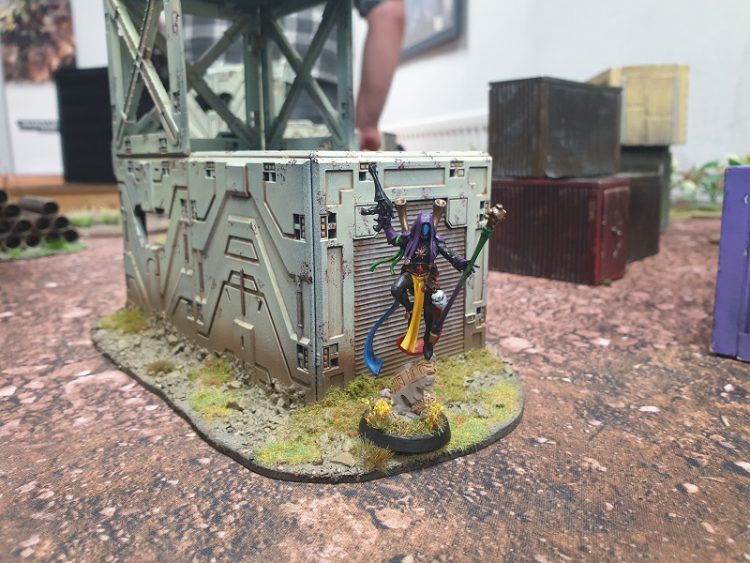
Harlequins
The Craftworld Eldar received a new Codex in March 2022, which also includes rules for Harlequins and Ynnari. The Codex has everything you need to play the faction in Matched Play and Crusade, with special sections for the Harlequins.
Ynnari
The Ynnari are now considered a subfaction of Craftworlds Eldar. Codex: Aeldari has everything you need to play the faction in Matched Play and Crusade.
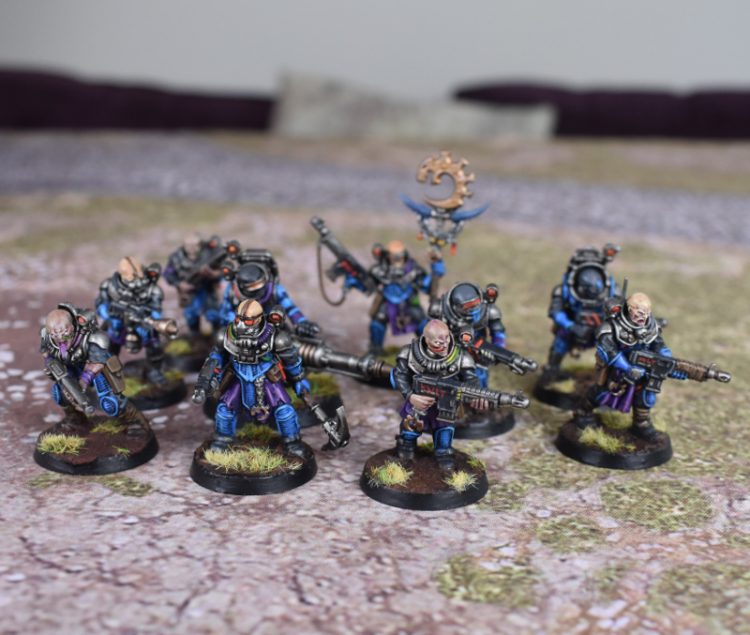
Genestealer Cults
Genestealer Cults received a new Codex in February 2022 that includes everything you need to play the army in matched play or Crusade. That said, GSC are unique in that they can take their own units as per the Codex, but they can also take a single “Brood Brothers” detachment which draws units from the Astra Militarum codex. If you want to do that, then also refer yourself to the Astra Militarum section above – you’ll need the Codex and FAQ, and you can take the Forge World units Guard can, though GSC have no Forge World units of their own.
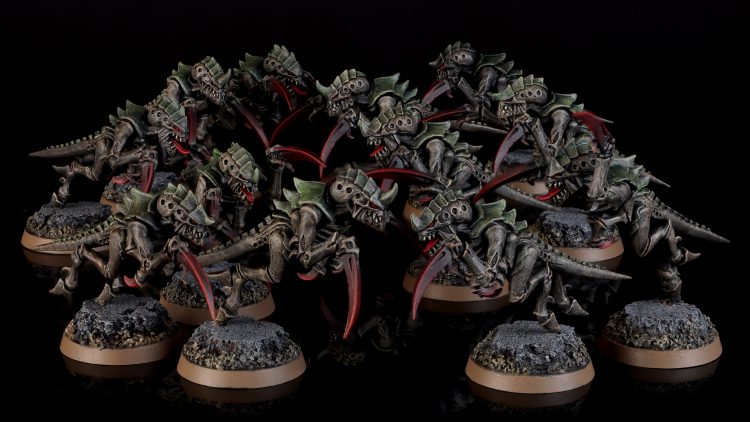
Credit: Pendulin
Tyranids
Tyranids received a new Codex in May 2022 that contains everything you need to play the faction in Matched play and Crusade.

Necrons
Necrons are nice and simple, with a shiny new 9th edition codex consolidating everything about them and haven’t really gotten anything since. They have a few cool units in the Forge World compendium. The Codex has everything you need to play the faction in Matched Play and Crusade, and the Balance Dataslate makes a number of important changes, giving many units the CORE keyword.
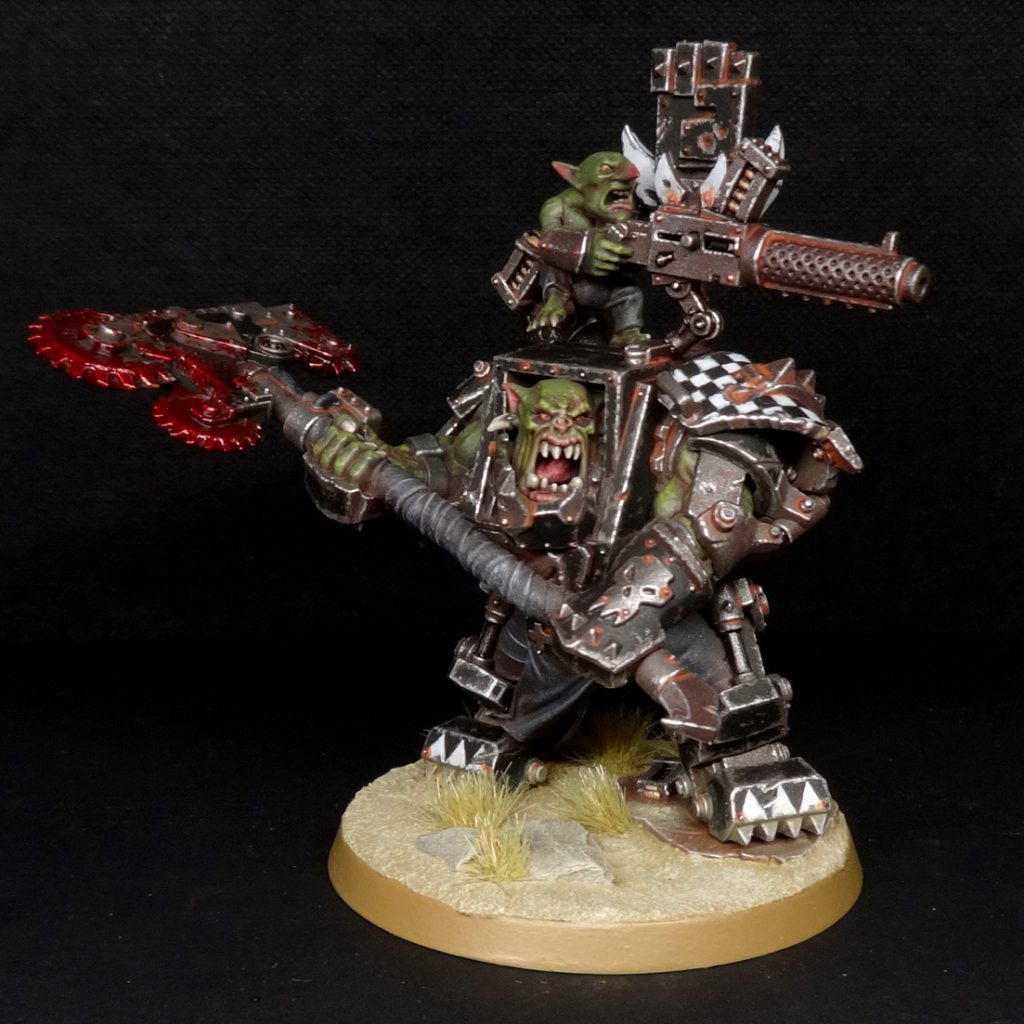
Orks
The Orks received a new Codex in mid 2021 and have since seen a number of changes and adjustments.
- The Codex has the basic rules for playing the army in Matched Play and Crusade, but be sure to pick up the Balance Dataslate for some faction-specific changes.
- War Zone Octarius Book 2: Critical Mass has a Codex Supplement for Blood Axes and the Speed Freeks Speed Mob Army of Renown, both of which offer some powerful options.

T’au Empire
The T’au got a new Codex in March 2022 and it has everything you need to play the army in matched play or Crusade. You may also want the Balance Dataslate for faction adjustments and the Imperial Armour Compendium for some of their Forge World units.
Get Started!
So that’s it… for now, anyways. We’ll be updating this periodically as new rules are released in the future, keeping it up-to-date for new players. If you have any questions or comments, or if there’s anything we missed, drop us a note in the comments below or email us at contact@goonhammer.com.


